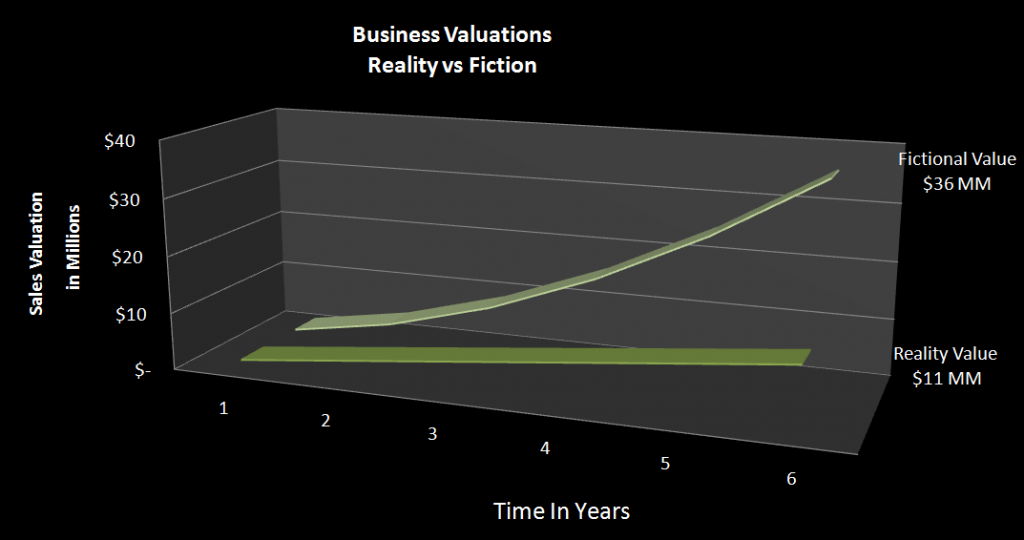Just Elementary, Inc. » Business Valuation, Featured » Business Valuation Too High Using Wrong Methodologies
Business Valuation Too High Using Wrong Methodologies
Many a client we have come across has a business valuation in their hands that is much higher than reality dictates. The reason for this is multi-faceted.
Let’s start with unscrupulous M&A sounding firms who claim to be able to sell businesses for outrageous multiples based on future earnings. Often, these types of firms put on slick presentations and claim to have sold many businesses for great premiums. In actuality, they charge obscene amounts of money ($30,000 and much more) to a client for a ‘special valuation’ where they promise to refund the money from the commission they collect when they find that magical buyer who will Grossly overpay. We have run into a few clients who believed the story and forked over the money. Unfortunately, all they were left with is an grossly expensive valuation that is useless and some five figures less in their business bank account. Here is an example:
Company X averages $6 MM (million) gross revenues in the last 4 years with a steady average EBITDA of$ 750,000 in the last four years. Company X has been around over 20 years and is in a mature industry. Typical EBITDA multiples for an expected sales price in reality are going be somewhere between 3 and 6 times. However, these shady firms will start to project huge sales increases and profit increases for the next 3-5 years and then apply a high EBITDA multiple. So for Company X they would project EBITDA to grow to $1,750,000 and apply some formula that disproportionately weighs the future projected earnings. So they would come up with some exaggerated value like $15 MM, when reality is more like $2-5 MM. The worse part of this scam is that they will claim to market for a buyer, but we have been told by more than person who got suckered that not one real buyer came. No surprise there, buyers with millions of dollars tend not to be suckers for overpriced businesses, and so the scam companies don’t even bother sending any buyers.

Another scenario in which valuations come in too high are ones in which an accountant applies theoretical valuations based on the financials and balance sheet that don’t take into consideration negative factors that a buyer would have to deal with. Book valuations have their place, but are not too useful in real world situations involving an arms length transaction with a buyer. Buyers have to consider natural customer attrition and other transitional issues that affect their Return on Investment and thus the price they are willing to offer.
A third scenario in which valuations come in too high are ones in which the inventory amount is high relative to the amount of the gross revenues and gross profits. This is often the case with businesses that operate on slow frequency of inventory turns. It is also the case with businesses that deal in specialty parts and accessories. In these cases, we often see inventory amounts that can be above$2 MM, but the gross sales are around $1 MM and the net profit around $250,000. Unfortunately, in these cases, for a buyer to get a justifiable R.O.I., they would have to pay far less than $2 MM. What happens in these cases? Glad you asked, in the worst of scenarios, the business never sells, and the inventory is ultimately liquidated for pennies on the dollar. In the best case, a business owner takes deferred payments on the inventory, and thus allowing a buyer to make a reasonable return on the investment. In this case, it is like the buyer is buying the inventory as he/she needs it to make sales, instead of committing all the cash up front. Also, please note that inventory is subject to obsolescence, so as a seller be prepared to negotiate a discount on the inventory to reflect present value. From our experiences, negotiating the discount schedule on inventory in a heavy inventory business is the most contentious part of a transaction. In the cases where the inventory is ‘floored’ by a supplier, it is the third party ‘flooring’ company that has money at stake, and thus it is harder to negotiate payments deferred enough to justify a reasonable ROI for the buyer. This is rare though, as company that operate with floored inventory don’t usually stockpile too much inventory. The real challenge in flooring situations is to get the buyer qualified for a significant line of credit to afford the floored inventory.
A fourth scenario is similar to the inventory scenario, except that it applies to the the Furniture, Fixtures & Equipment (FF&E). FF&E are the tangible items that are critical to the operation of the business. In a lot of cases, especially long established companies, there is an accumulation of expensive equipment over time that makes the business operation smoother and more efficient. However, the resale value of this equipment can be really low, even though it may come with equipment financing loans that add a lot to the debt service. Just as in the inventory scenario, if the amount of the FF&E far outweighs a reasonable price for the buyer, then the seller has a problem on his/her hands. Dealing with a third party lender on the FF&E can make negotiating a sale challenging, and often it is the seller that bears the brunt of the financial pain, as the buyer and lending company will look to the seller for financial relief.
For practical, real world Business Valuations, use the form on the right to contact us, or contact our Client Care Manager, Sonia Chhabra, by telephone (888) 926-9193 or email cs@justelementary.com
Filed under: Business Valuation, Featured · Tags: Accountant, appraisal, business, CPA, Inventory, M&A, method, methodologies, valuation








